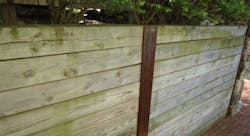ACQ and Aluminum Don’t Mix
As the industry phases out wood pressure-treated with chromated copper arsenate (CCA) in preparation for the Jan. 1, 2004, ban, keep in mind that the high level of copper in the alternatives—alkaline copper quarternary (ACQ) and copper azole lead the field—reacts with aluminum, causing corrosion.
Aluminum never has been recommended for use with CCA. Nonetheless, because it’s cheaper than the recommended brass or copper flashing or due to a lack of understanding, some builders use aluminum flashing in direct contact with pressure-treated lumber, creating a potential for leaks. Although most builders don’t use pressure-treated lumber beyond sill plates and decking. builders in the Southeast frame homes with it for termite protection.
Dave Mason, director of treated markets for the Southern Forest Products Association, says the first six months of 2004 will be interesting to watch, as he estimates that only about 15% of the CCA manufacturers in the United States have completed the transition to ACQ or other alternatives. The demand doesn’t exist yet because the alternative products cost 15% to 30% more than CCA.
The International Staple, Nail and Tool Association is watching the transition, too, and developing tests for the corrosiveness of different fasteners with the alternative treated wood products.
